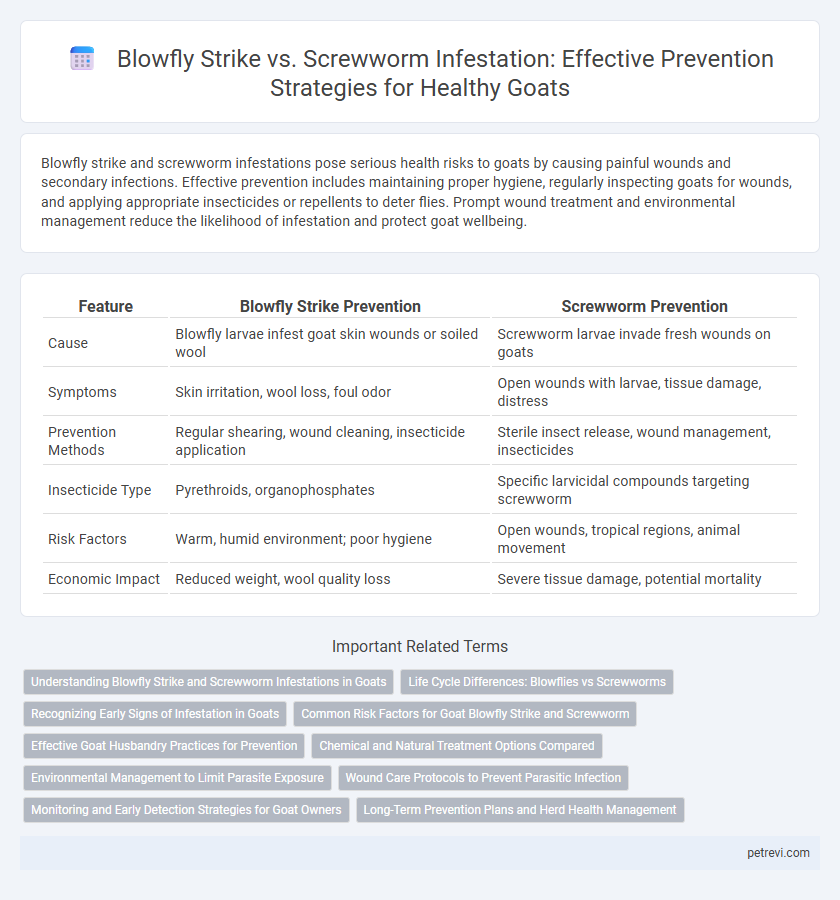Blowfly strike and screwworm infestations pose serious health risks to goats by causing painful wounds and secondary infections. Effective prevention includes maintaining proper hygiene, regularly inspecting goats for wounds, and applying appropriate insecticides or repellents to deter flies. Prompt wound treatment and environmental management reduce the likelihood of infestation and protect goat wellbeing.
Table of Comparison
| Feature | Blowfly Strike Prevention | Screwworm Prevention |
|---|---|---|
| Cause | Blowfly larvae infest goat skin wounds or soiled wool | Screwworm larvae invade fresh wounds on goats |
| Symptoms | Skin irritation, wool loss, foul odor | Open wounds with larvae, tissue damage, distress |
| Prevention Methods | Regular shearing, wound cleaning, insecticide application | Sterile insect release, wound management, insecticides |
| Insecticide Type | Pyrethroids, organophosphates | Specific larvicidal compounds targeting screwworm |
| Risk Factors | Warm, humid environment; poor hygiene | Open wounds, tropical regions, animal movement |
| Economic Impact | Reduced weight, wool quality loss | Severe tissue damage, potential mortality |
Understanding Blowfly Strike and Screwworm Infestations in Goats
Blowfly strike and screwworm infestations are critical concerns in goat health management, caused by larvae of blowflies and screwworm flies respectively that infest wounds or soiled fleece. Blowfly strike results from flies laying eggs on damp, dirty wool, leading to maggot infestation and severe tissue damage, while screwworm larvae invade open wounds and cause deep tissue destruction, potentially spreading infection. Implementing regular health checks, maintaining hygiene, and using appropriate insecticides or larvicidal treatments are essential strategies for preventing these parasitic infestations and ensuring goat welfare.
Life Cycle Differences: Blowflies vs Screwworms
Blowflies complete their life cycle in about 7 to 10 days, laying eggs on soiled or damaged skin where larvae quickly hatch and feed on tissue, causing blowfly strike. Screwworms undergo a similar parasitic larval stage but have a distinct life cycle lasting around 21 days, with females laying eggs on open wounds where larvae burrow deeper and cause severe tissue damage. Understanding these life cycle differences is crucial for timely intervention and targeted prevention strategies in goats, such as regular wound inspection and appropriate insecticide application.
Recognizing Early Signs of Infestation in Goats
Early detection of blowfly strike in goats involves identifying wet, discolored, or matted wool, alongside restlessness and frequent biting of the affected area. Screwworm infestation is recognized by open, foul-smelling wounds with visible larvae and surrounding tissue damage. Regular inspection of susceptible areas such as the perineum, wounds, and skin folds is critical for timely intervention and effective treatment.
Common Risk Factors for Goat Blowfly Strike and Screwworm
Goat blowfly strike and screwworm infestations share common risk factors including open wounds, poor sanitation, and high humidity environments that attract flies. Lack of regular grooming and compromised immune health increase vulnerability to both conditions. Identifying and managing these risk factors promptly is essential to prevent severe tissue damage and secondary infections in goats.
Effective Goat Husbandry Practices for Prevention
Effective goat husbandry practices for preventing blowfly strike and screwworm infestation include maintaining clean, dry living environments and promptly removing soiled bedding to reduce fly breeding grounds. Regular inspection of goats for wounds or fly larvae, combined with timely treatment using approved topical insecticides and wound care, significantly lowers infection risk. Implementing strategic fly control measures and proper nutrition boosts the goats' immune system, further enhancing resistance against parasitic infestations.
Chemical and Natural Treatment Options Compared
Blowfly strike in goats is commonly treated with synthetic insecticides like permethrin and cyromazine, while natural options include neem oil and diatomaceous earth for prevention. Screwworm prevention relies on systemic insecticides such as ivermectin and surgical removal of larvae, with natural remedies focusing on essential oils like tea tree and regular wound hygiene. Both conditions benefit from maintaining clean, dry environments and prompt treatment to minimize larval infestation and reduce chemical resistance risks.
Environmental Management to Limit Parasite Exposure
Effective environmental management plays a crucial role in preventing blowfly strike and screwworm infestations in goats by minimizing exposure to parasite larvae. Maintaining clean, dry bedding and promptly removing manure and soiled materials reduce moisture and organic matter that attract flies for egg laying. Implementing proper drainage and managing vegetation around goat housing further disrupts breeding habitats of blowflies and screwworms, thereby lowering infection risks.
Wound Care Protocols to Prevent Parasitic Infection
Effective wound care protocols are essential to prevent parasitic infections such as blowfly strike and screwworm in goats. Regularly inspecting goats for wounds, cleaning affected areas with antiseptic solutions, and applying appropriate insecticides or larvicides can significantly reduce infestation risks. Maintaining dry, clean bedding and promptly treating any skin injuries further disrupts the breeding cycle of these parasites, safeguarding goat health.
Monitoring and Early Detection Strategies for Goat Owners
Effective monitoring for blowfly strike and screwworm in goats involves frequent inspection of susceptible areas such as wounds, udders, and tail folds to identify early signs like larval infestation and tissue damage. Using traps and fly repellents helps reduce adult fly populations, while prompt treatment of skin lesions and maintaining hygiene minimizes breeding sites. Early detection through regular check-ups and staff training enables rapid intervention, preventing severe infestations and ensuring better goat health outcomes.
Long-Term Prevention Plans and Herd Health Management
Effective long-term prevention of blowfly strike and screwworm in goats involves regular flock inspections combined with strategic use of insecticides and fly traps to disrupt the lifecycle of these parasites. Implementing routine wound management, proper sanitation, and seasonal shearing reduces susceptibility and limits breeding sites for flies. Herd health management protocols should emphasize vaccination, nutrition, and biosecurity measures to enhance immune resilience and prevent infestation outbreaks.
Blowfly Strike vs Screwworm Prevention in Goats Infographic

 petrevi.com
petrevi.com